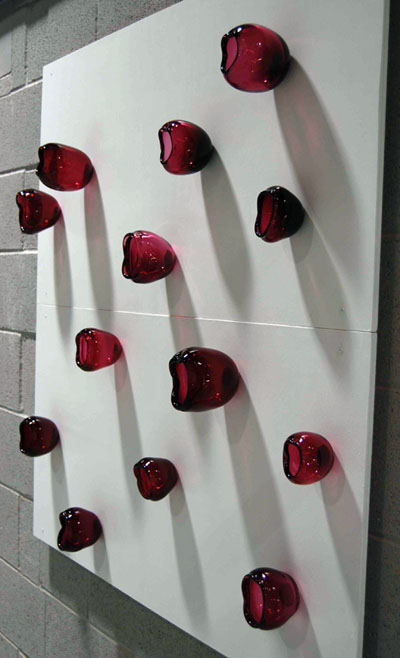We have become a Study in Glass
Dorothy Hardy, currently finishing her Glass and Ceramics BA Degree at Sunderland University, has taken inspiration from Bishopwearmouth Choral Society and created a stunning piece in glass, entitled ‘Interactive Choir’. Her approach is outlined below in her artist’s statement and it is hoped the members and friends of the Society will have the opportunity of viewing the piece itself at a performance.
Artist’s statement
I create portraits of anything that moves (physically or emotionally).
Investigation for each project starts with drawing, which I’m passionate about. In Autumn 2007, the challenge was to make work that would express what it feels like to sing in a choir: the sense of belonging that happens when singing as part of a group and the way in which very different individuals can sing together, forming a powerful, cohesive sound. It was exciting to have the chance to draw Bishopwearmouth Choral Society in rehearsal. After many scribbled drawings of singers standing in rows, there was the realisation that the visual interest and movement was in the mouths.
Then the challenge was to develop the studies in glass. Glass blowing gave a softness of line that made sense when making mouth shapes, so mouth-shaped vessels were blown in strong pink; each one a cartoon version of a mouth singing ‘Ah’.
Deciding on the best way to display the pieces was hard. A tactile piece was required: one in which the viewer is invited to take part.
This had been agreed in discussion with members of Bishopwearmouth Choral Society. There was a feeling that artworks that cannot be touched are often somewhat alienating and frustrating to view. The sense of touch can supply more information than may be received by vision alone, and adds to the experience of exploring a piece of art.
The drawings of the singing lips of a choir showed that a variation in height, rather than placing all mouths at the same level, makes for a more interesting composition than when the mouths are shown in one, fairly-level row. The idea of placing vessels at differing heights on the wall, also tallied well with the need to allow everyone to reach parts of the artwork easily, in order to interact with it. It is envisaged that viewers may wish to listen to the vessels, which amplify sound like large seashells. There is also the possibility of singing or shouting into the glass mouths, and playing with the resonant properties of each vessel. So the vessels have been placed at different heights: some accessible from as low as wheelchair height; up to pieces that tall adults would not have to bend down to examine. Only young children are prevented from accessing the piece directly: they will have to be lifted up in order to touch the glass vessels. This creates an inherent safety aspect to the work.
This piece may be read in differing ways. It can be an object to look at, so that the idea of a choir projecting their voices towards the viewer is experienced. It can also invite the audience in, as part of the choir, by being interactive.
Next work
Inspiration from choirs has continued, so that there are now two new artworks that have followed on from the studies of Bishopwearmouth Choral Society.
The plan is to draw together the artistic and engineering sides of my career. (My original training was as a Professional Mechanical Engineer.) I’m applying to Heriot-Watt University and Edinburgh College of Art to investigate the incorporation of solar cells into architectural glass. This is really exciting, as it involves renewable energy in art. Working with glass normally involves the use of large amounts of energy. This study will find ways of compensating for this to some extent by creating art that generates electricity from sunlight.





